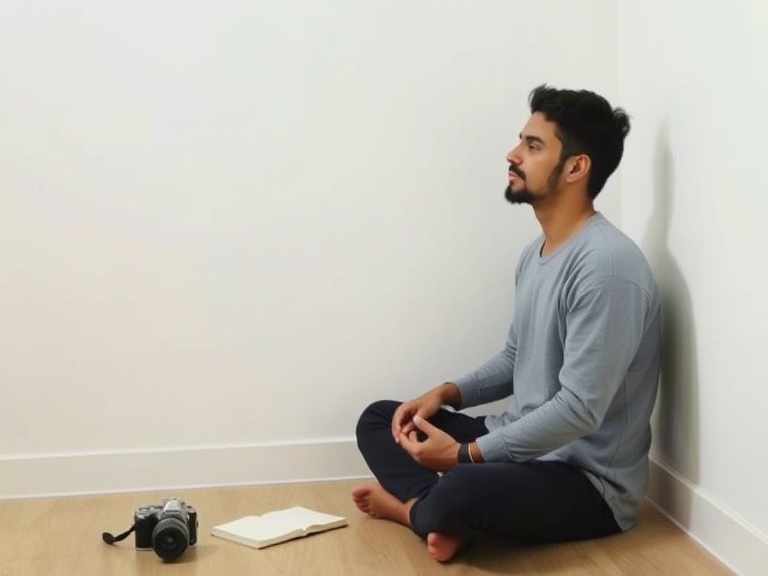Is Sitting with Music a Form of Meditation? With the advancing speed of the people in the modern world, it is a fundamental objective for everyone to look for ways in which they can calm themselves down, relieve stress, and achieve peacefulness. In recent years, an increasing number of people have turned to meditation practices in order to bring about this peaceful balance and calmness within themselves. Nevertheless, some people have doubts as to whether it is actually possible to approach the act of quiet coping with music as a meditation technique. Is this merely a passive form of restoration or does it encompass mental and spiritual healing similar to what one undergoes in prayer and meditation practices?
In this post, we shall make an inquiry into sitting with music, for example, whether it is meditation, its advantages, and how it is done.
1. What is Meditation?
Meditation is a process that involves an individual employing a technique such as an object musing or deep breathing or mindfulness to mobilize the focus and awareness. It is concerned with getting a state of the mind devoid of any clouding thoughts or whining emotions. Most of the traditional methods of meditation involve being quiet while concentrating on the breath or a sound or a word.
Some of the categories of practices that fall under this broad heading include:
- Mindfulness Meditation
- Transcendental Meditation
- Loving-Kindness Meditation
- Guided Meditation
There are variations in the emphasis for the types but the purpose of all of them is still to focus the mind and attain relaxation.

2. Is Listening to Music Meditation?
One can pass the time with music in a more meditative manner, and a more purposeful one at that. The key point is that ‘meditation’ does not only mean silence. It might also refer to control and direction of the mind, restoration of its order, and in doing so music may assist. But if you just stay still and listen to the music raptly and undistracted, then it becomes a type of meditation.
Here’s the alignment of sitting with music with meditation:
2.1. Focusing Attention
When one is seated with music, takes an active engagement on the sound, rhythm, or even the melody, that person practices focusing attention. In the same way that a meditator spends much of their time focused on the breath, that is the same way sitting with music can be used to draw the attention to the present moment by engaging in the various elements of music.
2.2. Stillness of the Mind
Tallerman, L. Williams and Verghese design describes the goal of the practice in tracing the meaning of oneself through cessation of an external narrative. Within certain genres, such as light jazz, sylvan soundscapes, or post-rock music, a logical content is conveyed to enable the listener to concentrate and calm the atmosphere. So, when one dons some music encumbered with some external stresses and during normal meditation, these stresses are similar.

3. Pros of Sitting in Music as a Meditation Practice
Whether you are engaging in pragmatic techniques of meditative traditional methods or sitting with music, both have mental, emotional and physical benefits. Key benefits of music meditation are listed below.
3.1. Detresses and Alleviates Anxiety
Our emotions are provoked directly by music. That is the reason why when we listen to some relaxation pieces whilst meditating, it helps in relieving some level of stress and anxiety. The soft beats and soft tunes relax the mind and calm it down from the hustle and bustles of life allowing one to forget their worries for a while.
3.2. Enhances Focusing and Concentration levels.
Even the exercise of paying attention to the sound level of the music whereby focuses its sound layers and tracks calls for the use of concentration and focus respectively. With practice, this is the little skill that can facilitate and improve your concentration in all activities that involve your brain power, especially in the capabilities of managing the distractions faced during the day.
3.3. Promotes Emotional Health
Some genres of music can foster pleasant feelings, and happy emotions can be restored within the individual. If you are meditating with inspiring or soothing music, you can experience emotional catharsis and satiety. This particular type of meditation can be healing in difficult situations and help adjust to pleasant feelings.

3.4. Increases Imagination Power
It has also been proven that creativity can be set free when one listens to music that is played in the background as one meditates. While this is happening, the mind is at ease, and there is no everyday pressure any more and thus, great inspirations can come from that change. Most creative people like painters and authors think that during music meditation they are more creative than without such practice.
3.5. Enhances Already Existing Sleep
For those who suffer from sleepless nights, or those who toss and turn in bed without sleep for long music meditation can come in handy. Soothing sounds especially slow beats, gentle sounds, and music relaxing all help in getting the body and mind into the sleep mode. This can be turned into a pleasant pre-sleep activity.

4. Music Meditation Practice Steps
Music meditation is very simple and its practice can easily fit into the daily schedule. Meditative music is suited for both initial beginners and more advanced practitioners of this active form of meditation. Here is how to begin:
4.1. Pick Appropriate Music Well
Make use of soothing music and appropriate mood music. If not keywords, it is ideal then to listen to pieces without lyrics like instrumental music, sounds of the environment, or nature songs. Many people who like or practice this kind of meditation most often include classical music or sound healing frequency in the process.
4.2. Locate an area that is suitable for you
Etc more suggestive intimate space/setting where you are less likely to be interrupted. You can choose to sit on the floor, in a chair, or lie down in case that is more preferable. In short, the aim is to be in a position where the entire body can relax whilst focusing on the external features especially the music.

4.3. Close Your Eyes and Breathe
It is good practice to take a few deep breaths prior to playing any music in order to ease into the process. Concerning this, after turning the music off, close your eyes and concentrate on your breath for one or two minutes. It will assist in calming your busy mind and readying you for the meditation.
4.4. Focus on the Music
At the point of onset of the music, dedicate all your attention to the sounds. The awareness of the beat, the up and down motion of the tune and the quality of each sound as per the different instruments in the song. As soon as you notice your wandering thoughts, redirect them back to the sounds.
4.5. Stay Here and Focus
The ability to endure time present in the moment is what makes it possible for music meditation to be effective. This is where the music resolves the issues at hand and portrays the situation at that time without losing control over thoughts on irrelevant ideas. Such aspect of practicing music is what differentiates it from just being an active listener- it is proper meditation.
4.6. Frequency of Practice
The same way it is with other forms of meditation, practice must be deliberate and frequent. Attempt to allocate time for this activity on a daily basis or on a few days every week if possible. Even short periods of 10-15 minutes can greatly enhance your condition.

5. Meditation-friendly Music Genres
In meditative practices, one can select from a plethora of music. Some individuals stick to one style whilst others use trial and error to define what fits them. Below are common categories of music used for meditation:
- Ambient music: Very soft electronic soundscapes that evoke calmness.
- Nature sounds: Sound tracks composed of rain, ocean waves or birds out there signing.
- Classical music: Features soundtracks of relaxing pieces by composers like Bach or Debussy or Chopin.
- Sound healing frequencies: Use of alternative music therapies that use certain frequences that are believed to induce relaxation and healing for instance 432 hz or 528 hz music.
- Guided meditation music: Music that consists of light tunes on the background as one follows the instructions ‘be guided by’ period.

Listening to music while seated, in many instances, may be regarded as a meditative state especially if it’s done with attention and purpose. One can enjoy several benefits, and one such is the meditation by music practice by concentrating on the music, quieting the mind and being in the moment. Music meditation is a once and for all practice that is very easy to maintain in day to day activities in case one would like to ease tension, enhance concentration or raise emotional status.
Up to you to experience it, and see what incorporating music into meditation does for you!
